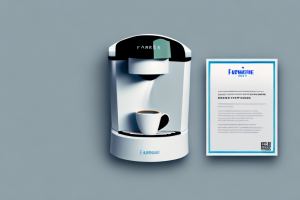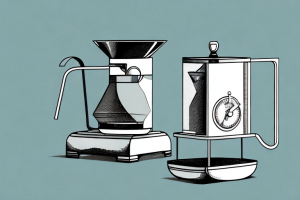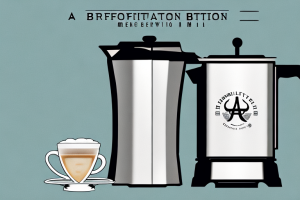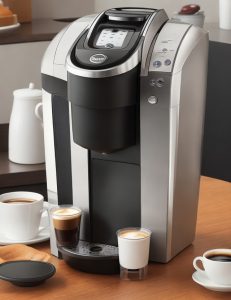Cleaning A Bunn Coffee Maker

A bunn coffee maker being cleaned
A cup of coffee is an essential part of many people’s morning routines. Preparing it can be a hassle at times, but it’s even worse when the coffee maker is dirty and affects the taste of the coffee. This is why it’s essential to regularly clean your coffee maker, specifically a Bunn coffee maker. In this article, we’ll discuss in detail how to clean your Bunn coffee maker thoroughly.
Why Clean Your Bunn Coffee Maker Regularly?
Before we proceed to the cleaning process, it’s essential to understand why regular cleaning is necessary. Coffee makers, just like any other kitchen appliance, need regular cleaning to function correctly. Over time, coffee deposits, oils, and minerals accumulate in the maker and can have an adverse effect on the quality of the coffee, not to mention the lifespan of the maker. A dirty maker is more likely to break down, leading to the expense of repairs or a replacement. Regular cleaning ensures optimal performance and a great tasting cup of coffee.
In addition to affecting the quality and lifespan of your coffee maker, a dirty coffee maker can also pose health risks. Bacteria and mold can grow in the warm, moist environment of a neglected coffee maker, which can lead to illness if consumed. Regular cleaning with a mixture of vinegar and water can help prevent the growth of harmful bacteria and keep your coffee maker in top condition.
Preparing Your Bunn Coffee Maker for Cleaning
Before starting the cleaning process, unplug your coffee maker and allow it to cool down. Make sure you have all the necessary cleaning materials ready, such as a soft brush for scrubbing and a lint-free cloth. You’ll also need white vinegar or a commercial coffee maker cleaner (depending on your preference).
It’s important to note that you should never immerse your Bunn coffee maker in water or any other liquid. Doing so can damage the machine and void the warranty. Instead, use a damp cloth to wipe down the exterior and removable parts.
Additionally, if you notice any buildup or residue in the water tank, you can use a mixture of water and vinegar to clean it. Simply fill the tank with equal parts water and vinegar, let it sit for 30 minutes, and then run a brew cycle with just water to rinse it out.
Cleaning the Exterior of the Bunn Coffee Maker
The exterior of the coffee maker is what’s visible, so it’s important to keep it clean. Use a lint-free cloth to wipe away any dust or grime. For stubborn spots, use a soft brush with mild detergent and warm water to scrub the exterior gently. Be sure not to get water or detergents into the coffee maker itself.
It’s also important to clean the coffee maker regularly to prevent the buildup of mineral deposits. These deposits can affect the taste of your coffee and even clog the machine. To clean the exterior, mix equal parts water and white vinegar and use a cloth to wipe down the surface. Rinse with water and dry with a clean cloth.
Finally, don’t forget to clean the coffee pot and filter basket regularly. These parts can harbor bacteria and affect the taste of your coffee. Wash the pot and basket with warm, soapy water and rinse thoroughly. You can also use a mixture of water and vinegar to remove any stubborn stains or buildup.
Removing Mineral Buildup from the Water Reservoir
The water reservoir is where water is stored before brewing. Over time, minerals from the water can accumulate in the reservoir, leading to the buildup of mineral deposits. To remove these deposits, use a solution of white vinegar and water. Pour equal parts of vinegar and water into the water reservoir and switch on the coffee maker. After a few minutes, turn it off and allow the solution to sit for an additional 30 minutes before rinsing the reservoir with clean water thoroughly.
It is important to regularly clean the water reservoir to prevent the buildup of mineral deposits. If left uncleaned, these deposits can affect the taste of your coffee and even clog the coffee maker. To avoid this, it is recommended to clean the reservoir every 1-3 months, depending on the frequency of use and the hardness of the water in your area. Additionally, using filtered water can also help reduce mineral buildup and prolong the lifespan of your coffee maker.
Cleaning the Sprayhead to Ensure Optimal Brewing Performance
The sprayhead is an essential component that disperses water evenly over coffee grounds during brewing. If it’s clogged or dirty, you’re likely to get an uneven brew. To clean it, use a soft brush or toothbrush to scrub it gently with mild detergent and warm water. Rinse the sprayhead, and it’s ready for use.
It’s important to clean the sprayhead regularly to maintain the quality of your coffee. Depending on how often you use your coffee maker, you may need to clean the sprayhead once a week or once a month. If you notice that your coffee is tasting bitter or weak, it may be a sign that the sprayhead needs cleaning.
In addition to cleaning the sprayhead, it’s also important to descale your coffee maker regularly. Over time, mineral deposits can build up inside the machine, which can affect the taste of your coffee and even damage the machine. To descale your coffee maker, follow the manufacturer’s instructions or use a descaling solution specifically designed for coffee makers.
Descaling Your Bunn Coffee Maker to Remove Lime Deposits
Lime deposits are caused by high mineral content in the water. They can build up in the coffee maker’s tubing, leading to restricted water flow and a diminished brew. To remove lime deposits, use a commercial coffee maker cleaner or a solution of white vinegar and water. Run the solution through the coffee maker as though you’re brewing coffee, making sure to follow the recommended cleaning time and dilution ratio. Rinse the machine thoroughly afterward.
It’s important to descale your Bunn coffee maker regularly to maintain its performance and extend its lifespan. The frequency of descaling depends on the hardness of your water and how often you use the machine. If you notice a decrease in the quality of your coffee or the machine is taking longer to brew, it’s a sign that it’s time to descale. Regular descaling will also prevent the buildup of bacteria and other harmful substances in the machine, ensuring that your coffee is always fresh and safe to drink.
Using Vinegar to Clean Your Bunn Coffee Maker
Vinegar is an effective cleaning solution that can be used every few months to remove dirt and grime from the coffee maker. Pour equal parts of white vinegar and water into the reservoir and switch on the coffee maker. After a few minutes, turn it off and allow the solution to sit for 30 minutes before running a cycle of clean water through it. Rinse the reservoir, and your coffee maker is ready for use.
It is important to note that using vinegar to clean your Bunn coffee maker may leave a slight vinegar smell in the machine. However, this smell will dissipate after a few uses. Additionally, it is recommended to clean your coffee maker regularly to ensure the best tasting coffee and to prolong the life of the machine.
Using a Commercial Coffee Maker Cleaner to Clean Your Bunn Coffee Maker
Commercial coffee maker cleaners are specially formulated to remove dirt and grime from coffee makers. They’re easy to use and more effective than vinegar or water solutions. Choose a cleaner that’s compatible with your Bunn coffee maker and follow the recommended cleaning instructions.
It’s important to clean your Bunn coffee maker regularly to ensure that it continues to produce high-quality coffee. Over time, coffee oils and mineral deposits can build up in the machine, affecting the taste of your coffee. Using a commercial coffee maker cleaner is a quick and easy way to keep your Bunn coffee maker in top condition.
When using a commercial coffee maker cleaner, be sure to follow the instructions carefully. Most cleaners require you to mix the solution with water and run it through the machine several times. After cleaning, rinse the machine thoroughly with water to remove any remaining cleaner. You may also want to run a cycle of plain water through the machine to ensure that all traces of the cleaner are removed.
Tips for Maintaining a Clean and Well-Functioning Bunn Coffee Maker
Regular cleaning will ensure that your Bunn coffee maker is in top working condition. It’s also important to note that the quality of the coffee will be affected by the water quality, so use filtered water whenever possible. Always rinse the coffee pot after use and allow it to air dry. Lastly, follow the manufacturer’s instructions for use and cleaning, and your coffee maker will be in excellent working condition for years to come.
In conclusion, your Bunn coffee maker requires regular cleaning to ensure optimal performance and longevity. It’s important to clean the exterior, remove mineral buildup in the reservoir, clean the sprayhead, and descale the maker regularly. Use vinegar or commercial coffee maker cleaners for effective cleaning. With these guidelines, your Bunn coffee maker will remain in top condition for years.
Another important factor to consider when maintaining your Bunn coffee maker is the type of coffee beans you use. It’s recommended to use high-quality, freshly roasted beans for the best flavor and aroma. Stale or low-quality beans can affect the taste of your coffee and may even clog the machine. Additionally, it’s important to store your coffee beans properly in an airtight container away from heat and light to preserve their freshness.
Lastly, it’s a good idea to periodically check the water temperature of your Bunn coffee maker. The ideal brewing temperature for coffee is between 195-205°F (90-96°C). If the water temperature is too low, the coffee may be weak and under-extracted. If the water temperature is too high, the coffee may be bitter and over-extracted. You can use a thermometer to check the water temperature or simply observe the brewing process to ensure the water is heating properly.



